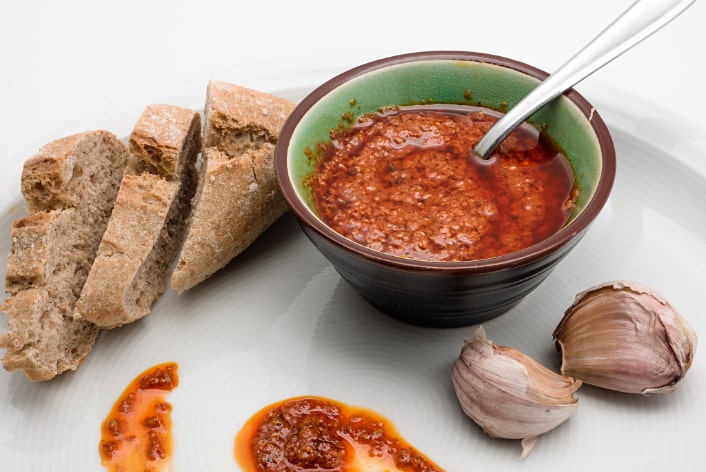Home
Ibérico Taste Blog
Discovering the most popular Spanish Dressings: Alioli, Salsa Brava and Mojo Picón

Discovering the most popular Spanish Dressings: Alioli, Salsa Brava and Mojo Picón
by Guillermo Pabon Garcia
on May 27, 2024
Summer is approaching, and with the good weather come barbecues and gatherings with friends. In Spanish cuisine, we have an abundance of sauces and dressings that will make you the king of summer, a result of the numerous cultures that have occupied the Iberian Peninsula, such as the Romans and the Moors, leaving a unique gastronomic legacy in the world. All of these can be made with simple, healthy ingredients, making them easy to prepare at home. Next, we’ll discuss some of the most common sauces at any event in Spain: salsa brava, mojo picón, and alioli.
What Makes Spanish Dressings Unique?
Spanish dressings are famous for the quality of their ingredients, their rich and vibrant flavors, and their mildness, unlike other sauces around the world, where spiciness and strong flavors dominate.
Key Ingredients in Spanish Dressings
Although different from one another, there are some ingredients used in many sauces, which are primarily:
Olive Oil: The Star Ingredient
As you probably know, olive oil is a key element in Spanish cuisine, especially in dressings, particularly extra virgin olive oil, known for its robust flavor and numerous health benefits. Its deep, fruity notes are a perfect complement to fresh vegetables and typical Spanish meats, or simply enjoyed on a piece of toast.
But it’s not just delicious; it’s a superfood with countless health benefits. Its high content of monounsaturated fats and antioxidants makes it a healthy option recommended for heart health.
Sherry Vinegar
The perfect complement to olive oil in any Spanish sauce. Sherry vinegar adds an acidic touch that contrasts perfectly with the oil’s flavor. The most well-known and appreciated is Jerez vinegar, produced in the Jerez region (Cádiz). This vinegar is aged and develops a complex and slightly sweet flavor that enhances many dishes, including desserts!
Spanish Spices and Seasonings
As a Mediterranean country, Spain is rich in spices. This is perhaps one of the main heritages left by the Arabs during their approximately 700 years on the Iberian Peninsula. Commonly used spices include Spanish saffron and smoked paprika, in Spanish Pimenton de la Vera, which provide a distinctive flavor and color, or ñoras, a type of red pepper used in many traditional Spanish recipes like paella. Additionally, other herbs such as parsley, cilantro, thyme, and oregano add more flavor and a fresh touch to dressings, completing the aromatic profiles.
Garlic
Garlic, another staple of Spanish cuisine, also plays a crucial role in many sauces. It brings strong, slightly spicy, and aromatic notes that are synonymous with Spanish cooking.
Common Sauces and Dressings in Spain
The culinary delights of Spain feature a variety of iconic sauces that elevate any dish. These sauces showcase the country’s rich and diverse gastronomic tradition.
Mojo Picón: The Treasure of the Canary Islands
Mojo picón, originating from the Canary Islands and spread throughout the country, is a spicy and flavorful sauce. Due to the geographical location of the Canary Islands, situated in the Atlantic Ocean at the level of Africa, its origin has African, Caribbean, and Portuguese influences. Made with cayenne peppers, a type of Spanish chili, red bell peppers, garlic, cumin, paprika, olive oil, and vinegar, it is known for its intense and unique flavor.
How to Pair Mojo Picón
Wrinkled Potatoes (Papas Arrugadas)
This sauce is famously served with "papas arrugadas," the most typical dish of Canarian cuisine. These are potatoes cooked with plenty of salt, then transferred to a hot pan or container without adding anything else until they become wrinkled, hence the name.

Fish and Seafood
It also complements meats and fish. Its balance of spicy and smoky flavors makes it a perfect complement to any baked or grilled fish or seafood.
Meats
Whether it’s chicken, beef, pork, or lamb, meats benefit greatly from the spicy and aromatic flavor of mojo picón. It can be used as a marinade before cooking the meats or simply as a side sauce to give a Canarian touch to meat dishes.
Salsa Brava: Spain’s Most Popular Spicy Sauce
Salsa brava is a very popular spicy sauce that gives rise to one of Spain’s most typical tapas, "patatas bravas." The sauce is made with tomatoes, cayenne peppers, garlic, oil, Sherry Vinegar, and paprika.
How to Pair Salsa Brava
Its name, "brava," implies a bold or fierce flavor, and it certainly lives up to that with its spicy kick. It is commonly served over fried potatoes but can also be used with meats for an additional spicy touch.

Alioli: Creaminess and Versatility
Alioli, a type of mayonnaise where the main ingredient is garlic. Although there are multiple variations, the original recipe is made with garlic, olive or sunflower oil, egg, a pinch of salt, and a few drops of lemon. This results in a creamy and spicy sauce depending on the amount of garlic used.

How to Pair Alioli
Meats
It pairs wonderfully with grilled meats, especially pork.
Seafood and Fish
Alioli adds a delicious flavor to any white fish or seafood.
Potatoes
Another typical Spanish tapa is potatoes with alioli. This is a very simple yet delicious dish: boiled potatoes mixed with alioli. Accompanied by some Spanish crackers like "picos camperos" and a beer, it’s a combination hard to beat.
Paella and Fideuà
Alioli is also used to enhance the flavor of some rice dishes, especially black Paella with seafood, and fideuà.
Recipes for Spanish Sauces
Mojo Picón
Ingredients:
- 2 roasted and peeled red bell peppers
- 3 cloves of garlic
- 1 teaspoon of cumin seeds
- 1 teaspoon of hot paprika
- 1/2 cup of extra virgin olive oil
- 2 tablespoons of red wine vinegar
- Salt to taste
Instructions:
- Roast the red bell peppers until charred; then peel and remove the seeds.
- 2. In a blender or food processor, combine the roasted peppers, garlic, cumin seeds, hot paprika, olive oil, and red wine vinegar.
- 3. Blend until smooth.
- 4. Season with salt to taste.
- 5. Serve immediately or refrigerate for up to a week.
Salsa Brava
Ingredients:
- 1/2 cup of extra virgin olive oil
- 1 small onion, finely chopped
- 2 cloves of garlic, chopped
- 1 teaspoon of hot paprika
- 1 teaspoon of sweet paprika
- 1/2 teaspoon of cayenne pepper powder
- 1 can of crushed tomatoes (approximately 400g)
- Salt and pepper to taste
Instructions:
- Heat the olive oil in a pan over medium heat.
- Add the chopped onion and cook until translucent, about 5 minutes.
- Add the chopped garlic and cook for another minute.
- Mix in the hot paprika, sweet paprika, and cayenne pepper, stirring constantly.
- Add the crushed tomatoes and bring the mixture to a boil.
- Reduce the heat and let it cook for about 20 minutes, stirring occasionally.
- Season with salt and pepper to taste.
- Let it cool slightly before serving or store in the refrigerator for up to a week.
Alioli
Ingredients:
- 2 cloves of garlic, chopped
- 1 large egg yolk, at room temperature
- 1/2 cup of extra virgin olive oil
- 1 teaspoon of lemon juice
- Salt to taste
Instructions:
- In a bowl, mix the chopped garlic, egg yolk, and lemon juice.
- Slowly add the olive oil in a steady stream while continuously whisking to emulsify.
- Continue whisking until the mixture is thick and creamy.
- Season with salt to taste.
- Store in an airtight container in the refrigerator for up to a week.
Where to buy Spanish Sauces and Dressings
If cooking is not your forte, or you don’t feel like making the sauces, you can always buy them already packaged and imported from Spain, following traditional recipes. In this case, Ibérico Taste offers you the authentic flavors of Spanish tapas, providing these sauces as well as all the ingredients you need to make them yourself.
Explore the world of Spanish dressings and sauces with Ibérico Taste and bring the authentic flavors of Spain to your kitchen.

